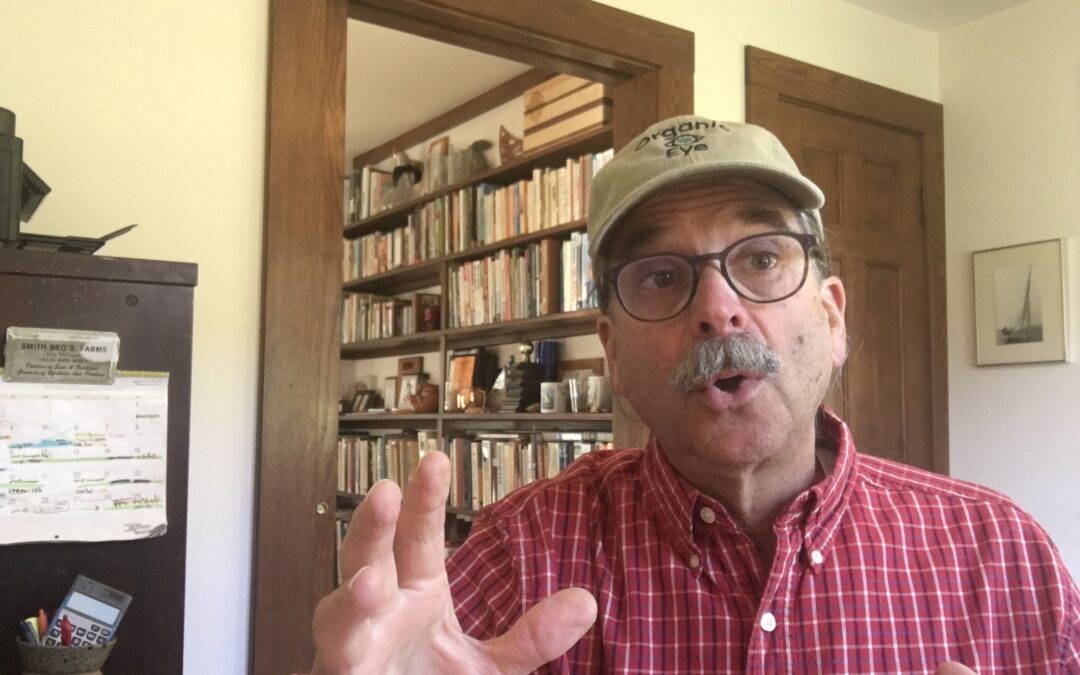Mark Kastel testifying at the Fall 2022 NOSB meeting in Washington via Zoom from his La Farge, Wisconsin office.
Who’s drinking the organic Kool-Aid served up by corporate lobbyists?
Thank you, Mr. Chairman,
My name is Mark Kastel. I am the Executive Director of OrganicEye. We are a tax-exempt public interest group based in La Farge, Wisconsin and chartered by the IRS to do research and educational work.
I’m going to cover two subjects:
Conflict of interest, which is often mentioned by this panel and included on the agenda, but rarely substantively addressed.
And I’m going to speak to not only the board but the broader organic community about the opportunity to reassess personal and institutional positions on the “animal welfare” rule.
The rule is one of the largest betrayals I’ve witnessed in my over 35 years of being involved in the organic farming movement, with most of the past two decades spent as an organic industry watchdog.
It’s like everyone drank the organic Kool-Aid served by the most powerful industry lobby and just decided, “Let’s push through this rule, declare victory, and then go home.”
But it’s a sell-out. Who does it serve? It’s not going to change the fact that almost all the “organic” eggs in the market are produced by vertically integrated agribusiness giants or by more moderate agribusinesses depending on contract production—not by family farmers.
Not only do ethical family farmers lose, but chickens lose, and consumers lose. Don’t confuse “access to the outdoors” with chickens actually going outside. Based on my observations while visiting scores of operations, other than at smaller family scale-farms, virtually no chickens are outdoors now, and they won’t be after this rule goes through. There is no way to live a good chicken life under confinement conditions.
What kind of animal welfare is that?
1-2 ft² indoors and outdoors. That’s inhumane. And let’s chop off part of their beaks so they don’t injure each other due to the stress of confinement.
No chickens are going to go outside because there’s no food, water, or shade out there. And they can’t get to the few small doors without walking over thousands of birds to get outside. Furthermore, they aren’t going to walk over expansive concrete and gravel to get to a natural area to exhibit their instinctive behaviors, like foraging and dust baths (as is required by law).
And just as now, they will be afraid to go outside because they’ve never been outside. Unlike many smaller pullet growers who let their chicks out a few days after hatch, the new rule allows up to 21 weeks of total confinement before the little doors ever get opened.
We would welcome inquiries from other organic community members who are assessing or reassessing their positions on this rule and would call your attention to our formal comments on the rule which have yet to be submitted but are available at OrganicEye.org.
Conflict of Interest
Providing specific examples has been censored in the past and I don’t want to be gaveled down. So please try this real-world scenario instead:
Suppose one of the largest, multimillion dollar certifiers in the country certifies a multibillion dollar corporate agribusiness.
Besides the lucrative certification fees, which includes inspection of numerous contract growers, the corporation also handsomely contributes to the nonprofit associated with the certifier. That includes full-page advertisements in their glossy magazine, sponsoring conferences, and other financial support.
Both the certifier and the agribusiness are major contributors to the industry’s largest lobby and trade organization. The certifier lobbies the NOSB in support of their client’s use of materials being reviewed.
The certifier and corporation have both had employees hold seats on the NOSB, publicly debating—without recusal—issues that they and their clients have a financial interest in.
But don’t worry. The NOP has mitigated any potential conflicts of interest by making sure that the certifier and its nonprofit, receiving copious amounts of voluntary contributions, are separate.
Separate on paper.
In this scenario, the over 80 employees of both the certifier and nonprofit are housed in the same offices and report to the same CEO (one big happy family).
The NOSB, in the past, and the NOP seem not to recognize the term “conflict of interest.”
If you’re interested in more specifics and the identification of the certifier and agribusiness, please click on the contact tab at OrganicEye.org.
Board members, comprehensive OrganicEye written comments related to the full NOSB agenda have been submitted and I hope you will review them.
Thank you for the opportunity to speak.

